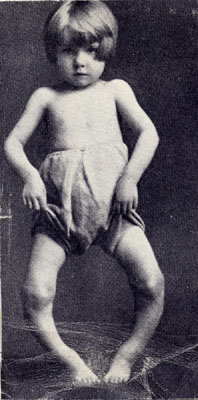
The distressing sight of a young child suffering from rickets, a childhood disorder involving softening and weakening of the bones, primarily caused by lack of Vitamin D, calcium, and/or phosphate. It is often associated with lack of exposure to sunlight. The photograph dates from around 1900.
Although rickets is not an infectious disease, it seemed to afflict deprived areas of Glasgow like an epidemic. The figures for 1902 show 329 cases for children aged from six months to two years, and 1,357 cases for those aged from two to ten years. Vitamin D supplementation did not begin until after the First World War and the initially high doses that were administered left some children with brain damage.
The knowledge that Vitamin D could combat rickets led Glasgow Corporation to encourage people to eat food which was rich in this vitamin. In 1940, Glasgow schoolchildren were given free cod liver oil and orange juice, a phrase that became immortalised in song.
Reference: Heatherbank Museum of Social Work, print 6371
Reproduced with the permission of Glasgow Caledonian University, Research Collections, Heatherbank Museum of Social Work
Keywords:
bones, children, cod liver oil, disabled children, diseases, girls, Glasgow Corporation, infants, medicine, orange juice, public health, rickets, sunlight, Vitamin D deficiency
You have 1 image in your photo album.